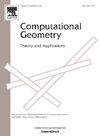Navigating planar topologies in near-optimal space and time
IF 0.4
4区 计算机科学
Q4 MATHEMATICS
Computational Geometry-Theory and Applications
Pub Date : 2023-02-01
DOI:10.1016/j.comgeo.2022.101922
引用次数: 0
Abstract
We show that any embedding of a planar graph can be encoded succinctly while efficiently answering a number of topological queries near-optimally. More precisely, we build on a succinct representation that encodes an embedding of m edges within 4m bits, which is close to the information-theoretic lower bound of about 3.58m. With bits of space, we show how to answer a number of topological queries relating nodes, edges, and faces, most of them in any time in . Indeed, bits suffice if the graph has no self-loops and no nodes of degree one. Further, we show that with bits of space we can solve all those operations in time.
在接近最优的空间和时间中导航平面拓扑
我们证明了平面图的任何嵌入都可以被简洁地编码,同时有效地回答许多接近最优的拓扑查询。更准确地说,我们建立在一个简洁的表示基础上,该表示将m条边嵌入4m位中,这接近于约3.58m的信息论下界。使用4m+o(m)位的空间,我们展示了如何回答与节点、边和面有关的许多拓扑查询,其中大多数在ω(1)中的任何时间。事实上,如果图没有自循环和一阶节点,3.58m+o(m)位就足够了。此外,我们证明了使用O(m)位的空间,我们可以在O(1)时间内求解所有这些运算。
本文章由计算机程序翻译,如有差异,请以英文原文为准。
求助全文
约1分钟内获得全文
求助全文
来源期刊
CiteScore
1.60
自引率
16.70%
发文量
43
审稿时长
>12 weeks
期刊介绍:
Computational Geometry is a forum for research in theoretical and applied aspects of computational geometry. The journal publishes fundamental research in all areas of the subject, as well as disseminating information on the applications, techniques, and use of computational geometry. Computational Geometry publishes articles on the design and analysis of geometric algorithms. All aspects of computational geometry are covered, including the numerical, graph theoretical and combinatorial aspects. Also welcomed are computational geometry solutions to fundamental problems arising in computer graphics, pattern recognition, robotics, image processing, CAD-CAM, VLSI design and geographical information systems.
Computational Geometry features a special section containing open problems and concise reports on implementations of computational geometry tools.

 求助内容:
求助内容: 应助结果提醒方式:
应助结果提醒方式:


